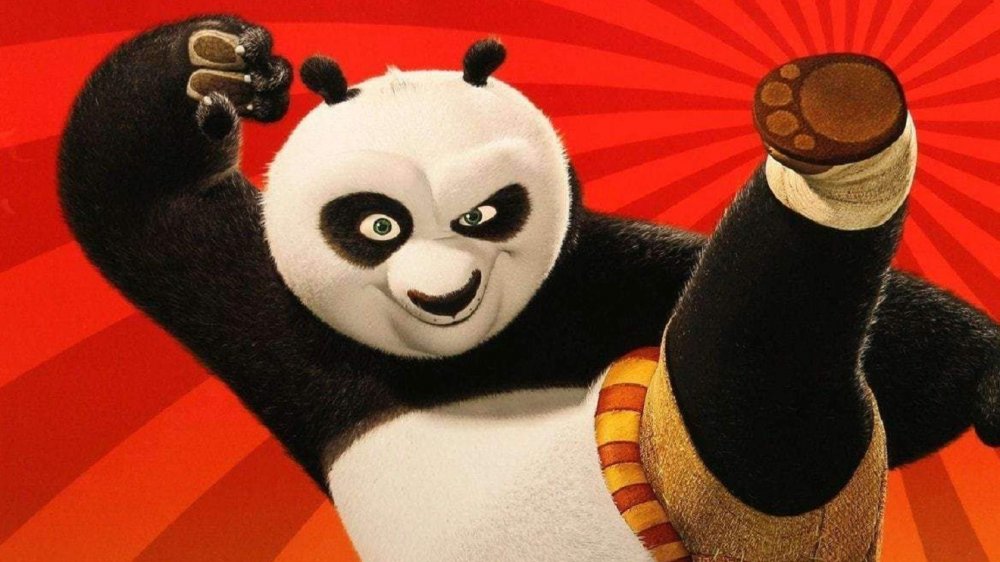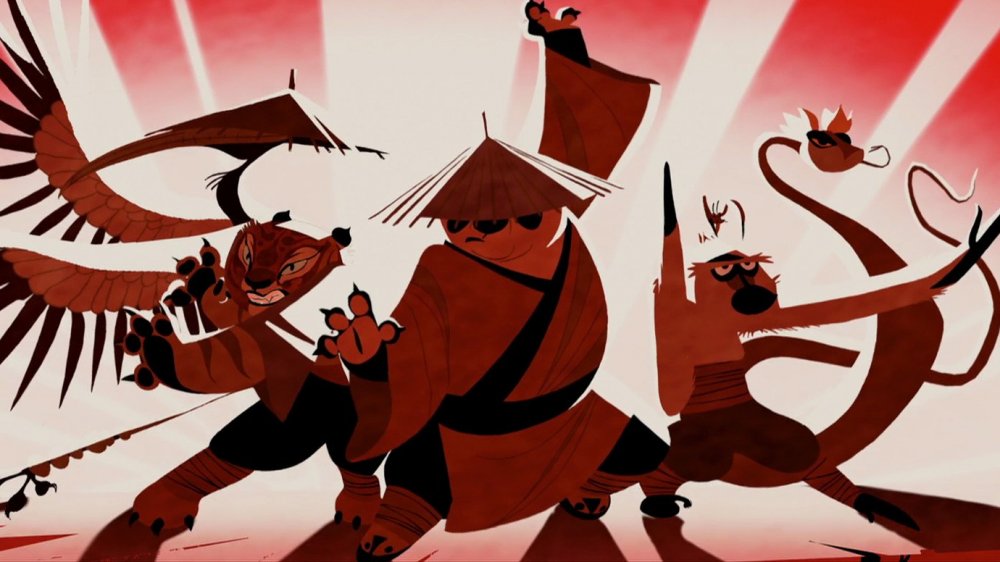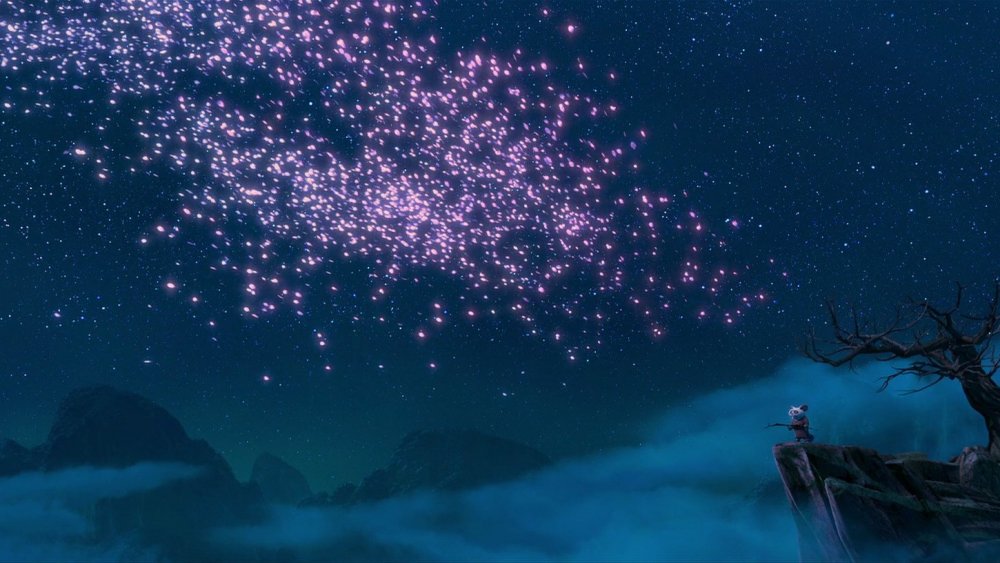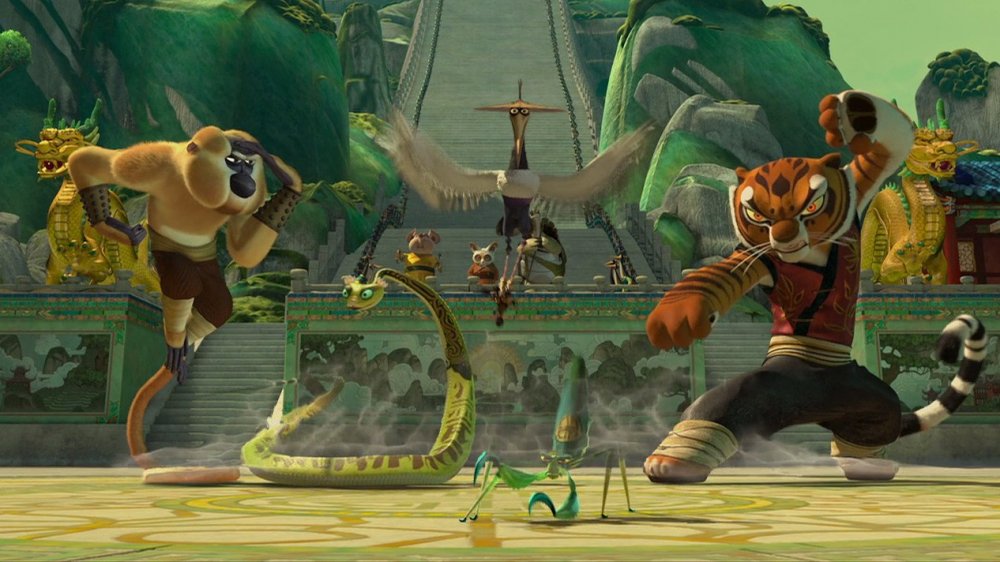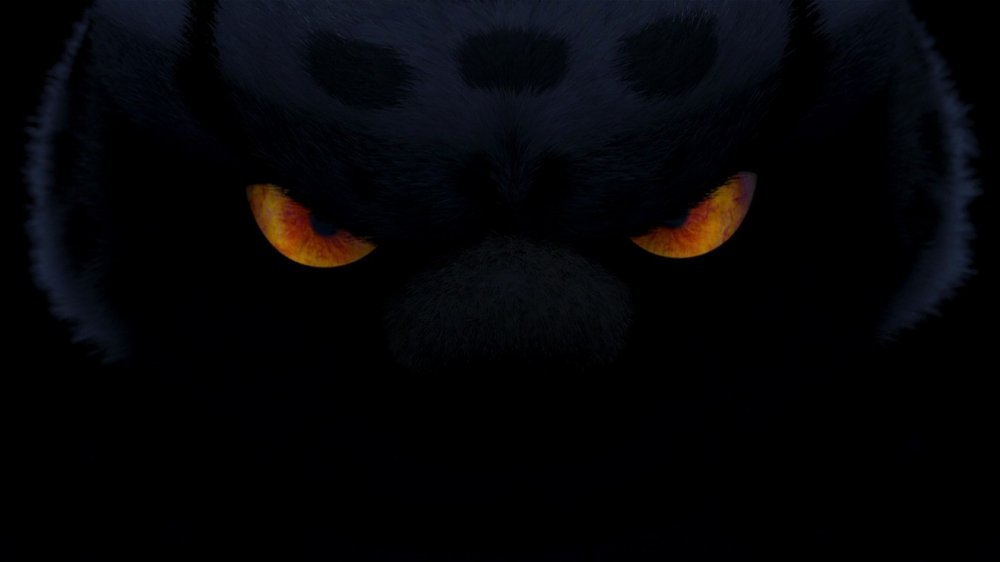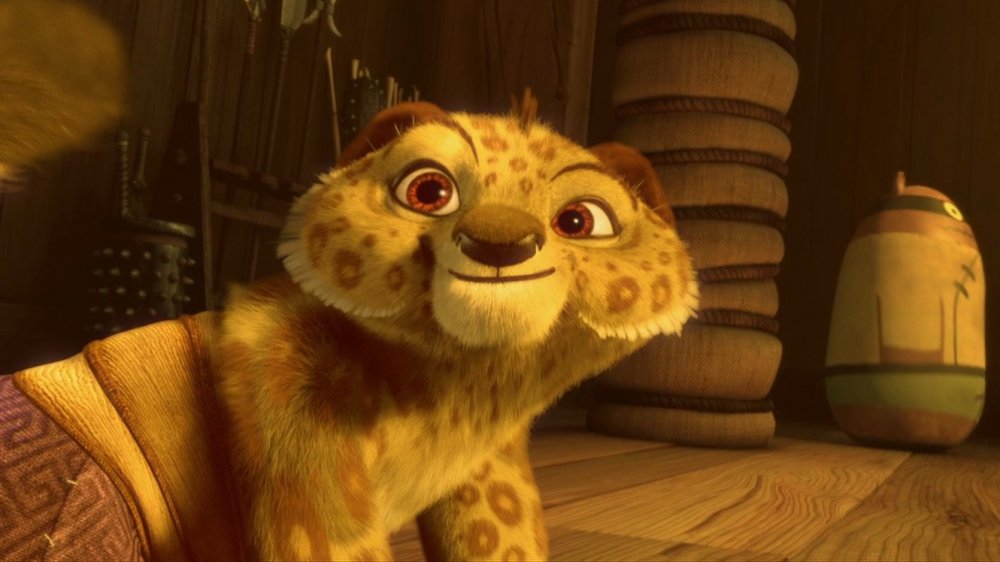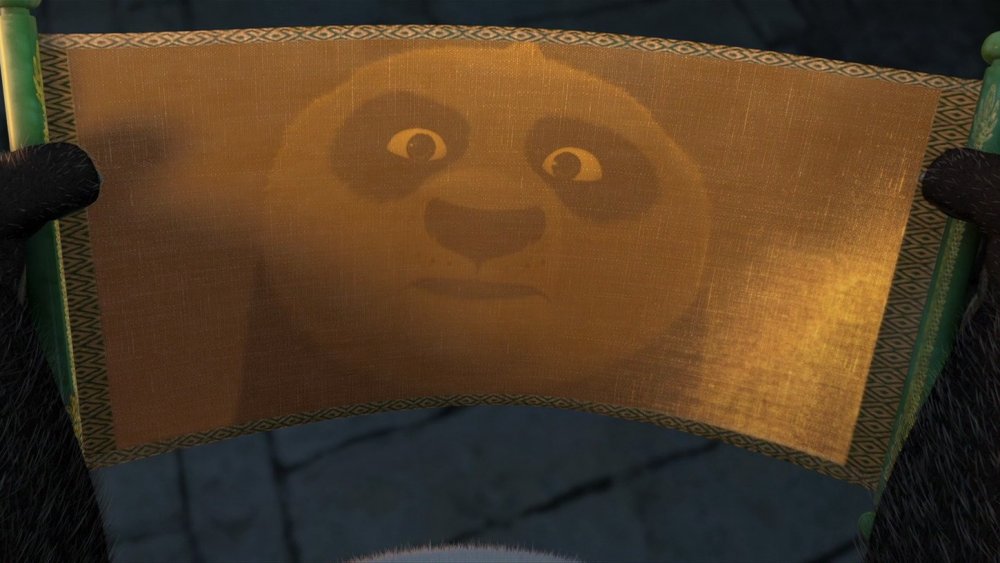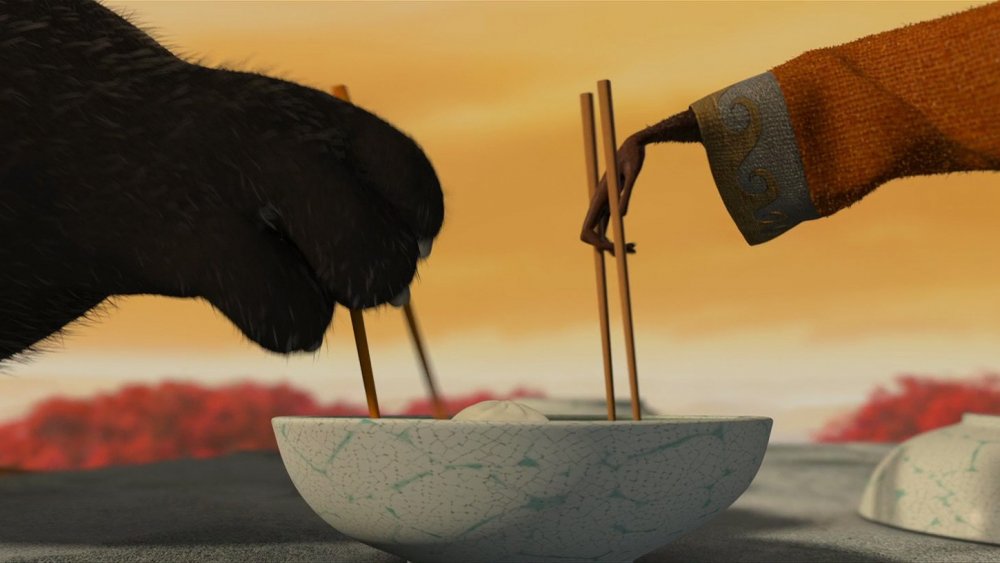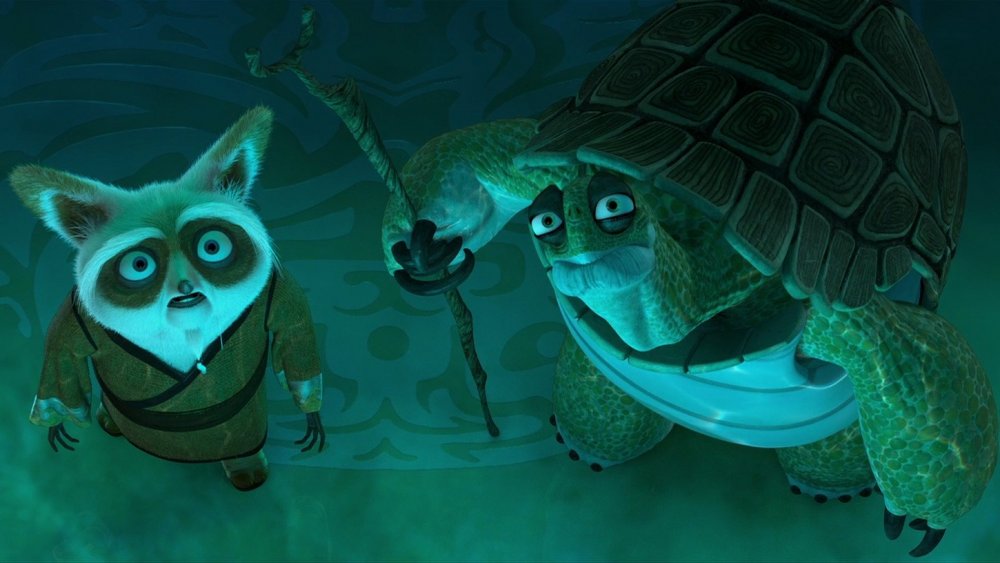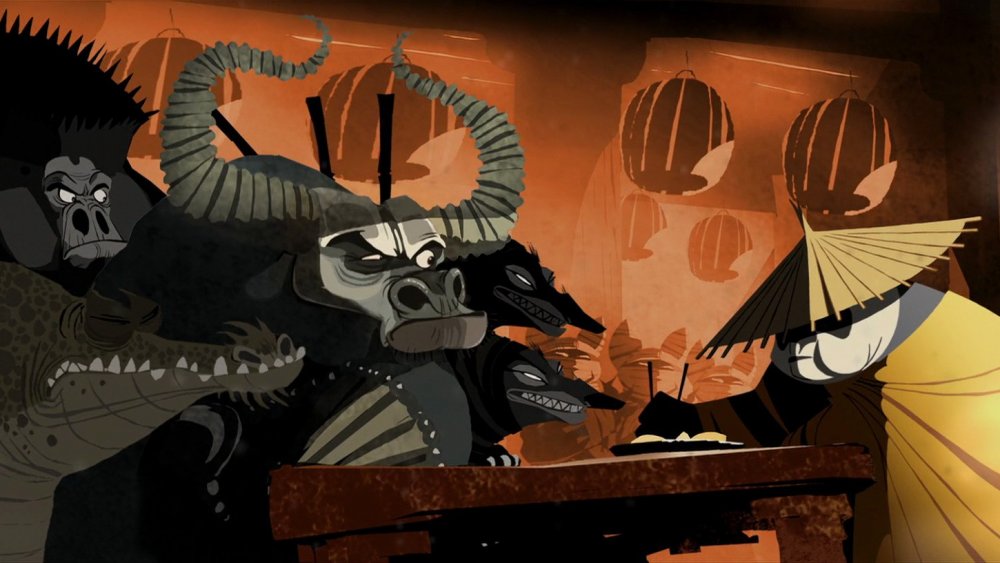Things Only Adults Notice In Kung Fu Panda
In many ways, Kung Fu Panda is a film that's easy to dismiss. It's an animated film by Dreamworks, a studio with a reputation of not having much to offer to adult audiences, especially compared to other animation studios like Disney and Pixar. It's also a comedy for kids about a clumsy chubby panda, with a prominent wacky comedian voicing the lead role. Any self-respecting grown-up would pass this film right by, but that would be an enormous mistake. Kung Fu Panda is a surprisingly complex, heartfelt, and lovingly crafted film, which stands heads and shoulders over the average family-friendly fare.
Today, we're taking a long look at this kids' movie through the eyes of adulthood. We'll be analyzing the plot, uncovering the deeper themes, and marveling at the wonderful craftsmanship of this film. There may also be some nitpicking, as being an adult means that it's sometimes very difficult to turn off that part of your brain that's always on the hunt for plot holes, but mostly, we'll be saying good things because this movie deserves it. If you were an adult who previously skipped Kung Fu Panda because you believed it was going to be a shallow cash grab, it may be worth your time to check out. And if you were just a kid the first time you saw the film, consider giving it a rewatch. This is the rare example of a children's film that can certainly grow up with its audience.
The Kung Fu Panda cast is stacked with A-listers
Young children who are watching Kung Fu Panda for the first time (or the hundredth time) most likely won't know and won't care who's providing the voice for a given bird or rhino in the background of a particular scene, but their parents will be stunned when they see how bafflingly star-studded this film is. The cast is packed with big-name movie stars, even down to the incidental supporting roles.
Comedian and musician Jack Black plays Po, the titular kung fu panda himself, and Po's father is played by long-time Hollywood veteran James Hong (Mulan, Blade Runner, Big Trouble in Little China). Dustin Hoffman plays Po's kung fu master, the red panda Shifu, and Randall Duk Kim (the Keymaker from The Matrix Reloaded) plays Shifu's master, the wise old turtle Oogway. The five greatest kung fu warriors in all of China — the Furious Five — consist of Angelina Jolie as Tigress, Lucy Liu as Viper, Seth Rogen as Mantis, David Cross as Crane, and Jackie Chan as Monkey. The main villain, Tai Lung, is played by Ian McShane of Deadwood fame, and the late Michael Clarke Duncan appears in a brief yet memorable supporting role as Commander Vachir.
The animation is way better than it needs to be
Children's films are viewed by some as a lesser form of entertainment. Because the intended audience is a bunch of caffeinated seven-year-olds, conventional wisdom states that there's no point actually making it good. The makers of Kung Fu Panda certainly didn't have this attitude. This seemingly disposable animated kids movie may in fact be, shockingly, one of the most beautiful animated films of all time.
The film opens with a highly stylized, anime-esque, hand-drawn sequence that's full of flat color and dynamic compositions. Then, when the film proper begins, the visual thrills don't slow down one bit. As we meet the cast, their character designs are varied, specific, and instantly communicate what each character is all about. The action scenes are breathtaking, on par with a great live-action wuxia film. The action is easy to read, dynamic, thrilling, and often funny, delivering cartoonish slapstick scenes without ever losing a feeling of weight or stakes.
But looking back on the film, it's the quiet moments we remember the most, like Po and his father preparing soup together, the heartbreaking and subtly acted final reunion between Shifu and Tai Lung, and Master Oogway dissolving away into cherry blossoms and floating away into the starry sky. Some of the imagery in this film is downright beautiful, and it'll stick with us rest of our lives, right alongside the best moments from Pixar, Disney, or Studio Ghibli.
The Furious Five are inspired by five different forms of kung fu
When Po begins his journey to learn kung fu, he has five senior students to look up to. They are the Furious Five — Tigress, Mantis, Crane, Monkey, and Viper. As you might imagine, each character's name tells us what kind of animal they are. But beyond that, the choice of making the Furious Five these specific animals contains an additional layer of meaning, as each corresponds to a different style of kung fu.
There are countless different styles of kung fu, many of which are named after animals. The five core Shaolin styles are tiger style, crane style, leopard style, snake style, and dragon style, but there are other styles as well, such as mantis style and monkey style. It should be fairly obvious which form of kung fu is favored by each member of the Five, and if you guessed that leopard style is the form of kung fu practiced by the snow leopard Tai Lung, you'd be right.
But what about dragon style? There may not be any dragons in the film, but there is a Dragon Warrior. Po largely fights with a cartoonish and slapstick hodgepodge of kung fu techniques (including bear style), as befits his character. However, some of his moves also appear to be based in dragon style, such as his signature "crazy feet" technique, which resembles dragon style footwork.
Adults will notice this dragon-sized plot hole
The inciting incident of Kung Fu Panda comes when the elderly turtle guru, Master Oogway, has a vision of the future, in which the evil Tai Lung breaks out of prison and seeks his revenge. In years past, Tai Lung was locked away for turning violent after Oogway denied his request to become the Dragon Warrior.
Oogway's pupil, Shifu, immediately dispatches a messenger to warn the prison staff. Then, as an additional precaution, the two kung fu masters decide to choose a student to become the Dragon Warrior so that they will have a protector on hand, just in case. When the messenger arrives at the prison and starts inspecting Tai Lung's security, the head guard, Commander Vachir, gets cocky. He starts taunting Tai Lung, telling him that he heard the Dragon Warrior is going to be chosen, and it won't be him. This revelation, that there will be a new Dragon Warrior, ends up giving Tai Lung the motivation he needs to escape.
Did you catch the logical misstep there? Since the decision to choose the Dragon Warrior wasn't made until after the messenger was dispatched, and this is a pre-telephone, pre-email era, how did Vachir learn that the Dragon Warrior was going to be chosen before the messenger arrived? It's most likely just a small plot hole, and it certainly doesn't ruin the film or anything, but it's the sort of minor error that the youngest viewers in the audience most likely won't catch at all. We caught it, though, because we're old and jaded and can't just enjoy things anymore.
Tai Lung is an extremely sympathetic villain
When we first meet the villain of Kung Fu Panda, Tai Lung, he's locked away in constant solitary confinement. He's chained face down to the floor, and his back is full of magic acupuncture needles that prevent him from moving. These living conditions are absolutely inhumane, so we're forced to ask, what did this character do to deserve this sort of treatment?
We finally get Tail Lung's origin story during a dinnertime conversation between Po and the Furious Five, in which we get to see Lung as an absolutely adorable baby snow leopard. As Tigress explains, "Shifu found him as a cub, and he raised him as his son, and when the boy showed talent in kung fu, Shifu trained him. He believed in him. He told him he was destined for greatness. It was never enough for Tai Lung. He wanted the Dragon Scroll. But Oogway saw darkness in his heart and refused. Outraged, Tai Lung laid waste to the valley. He tried to take the scroll by force."
Exactly what the phrase "laid waste to the valley" means is never precisely explained, and that's a shame. Why? Well, in order to settle our feelings on Tai Lung, we'd really appreciate some more detail. Sure, it's bad, but is it "chained face down 24 hours a day for the rest of your life" bad? Is it "it's okay for the hero to literally make your body explode with a secret kung fu technique" bad?
Kung Fu Panda's message is genuinely inspirational
Perhaps the most refreshingly and subtly grown-up aspect of this film is how it handles theme — the deeper messages within the story that tell us something about the real world. Though kids watch Kung Fu Panda for the action and comedy, parents can rest easy knowing that it also contains numerous great lessons for a young audience.
The first comes when Po finally opens the Dragon Scroll, which is said to include the secret to unlimited power and mastery of kung fu. Turns out the scroll is blank — just a shiny reflective surface in which Po can see his own face. Po doesn't fully understand at first, but later, everything becomes clear during a conversation with his father about their much revered "Secret Ingredient Soup." Po's dad finally tells him the secret of this old family recipe — there is no secret ingredient. As he puts it, "To make something special, you just have to believe it's special." Upon hearing this, Po realizes what the Dragon Scroll was trying to convey. There is no one magic secret to greatness. There's nothing that separates you from your idols, there is no "it" factor. You can achieve greatness all on your own.
Along similar lines, another theme of the film is the importance of learning in your own way. Despite his burning desire to learn kung fu, Po struggles terribly, and Shifu learns that the secret of teaching Po kung fu lies in harnessing Po's passion for food and using that as a motivating factor. This shows that one size does not fit all when it comes to training and education. What works for others may not work for you. You need to find your own path.
Kung Fu Panda borrows story elements from old kung fu movies
If you're a seasoned film fan, especially a kung fu movie fan, you may notice that Kung Fu Panda has been heavily influenced by 70's kung fu movies. We're not just talking about stylistic influences. We're talking about specific scenes and plot beats that may have just been directly lifted from other films.
The first film that Kung Fu Panda appears to borrow from is The Fearless Hyena, a 1979 comedy action film that was written by, directed by, and starring Jackie Chan. One of the film's most famous scenes occurs when a kung fu student and his master are eating dinner together. The master invites the student to take any food he chooses, but then he blocks all of his protege's attempts to eat by knocking his food aside with his chopsticks. This leads to a lightning-fast chopstick fight between the two men that contains several of the same moves and beats as the similar chopstick fight in Kung Fu Panda.
Another film that Kung Fu Panda seems influenced by is Circle of Iron from 1978. This film features a group of fighters competing in a tournament for the right to obtain an artifact known as the Book of Enlightenment from a wizard named Zetan. When our protagonist finally gets his hands on the book, he opens it up to find that all the pages are mirrors. Zetan explains that there are no answers, "no enlightenment outside yourself." The parallels between this book and the Dragon Scroll should be fairly self-evident.
The story is similar to many ancient myths about predestination
A recurring idea in many myths from all around the world is the idea that you cannot change your fate. In these stories, a character will typically learn of a bad fate that awaits them in the future. They will then attempt to change this fate, but in doing so, they will end up causing it. This happens most commonly in Greek mythology, such as in the stories of Chronos, Oedipus, and Perseus. However, similar stories also occur in Norse mythology, in the life of Baldur, and even in the Abrahamic religions, in the life of Joseph.
The plot of Kung Fu Panda borrows from this classic myth structure twice throughout the film. The first instance occurs in the backstory of Tai Lung. Master Oogway refuses to give Tai Lung the Dragon Scroll because he sees darkness within him, and he fears that Tai Lung will one day turn bad. This ends up being correct, but it's only because Oogway rejects him. Being denied the Dragon Scroll is the event that ends up pushing Tai Lung over the edge.
The other instance of a character causing their own prophesied doom comes when Oogway has a vision that Tai Lung will escape prison. Shifu, seeking to avoid this fate, sends a messenger to warn the prison. This messenger's visit, however, ends up causing Tai Lung's escape. This time, however, Oogway sees it coming. He warns Shifu, "One often meets his destiny on the road he takes to avoid it."
Kung Fu Panda's opening sequence foreshadows both of the sequels
Kung Fu Panda opens with a dream. Our protagonist Po is fantasizing about being a master of kung fu. He defeats endless hordes of deadly foes, gains the adoration of strangers, and even gets a chance to hang out with his idols, the Furious Five. Although the main function of this dream is to give us insight into Po as a character, it may be the case that it's also telling us something about the future. And we're not talking just about Po's future but the future of the Kung Fu Panda franchise.
Much of Po's dream does indeed foreshadow the events of the first film. By the end of the story, Po does become a kung fu master who's friends with the Furious Five. However, other elements of the dream go unfulfilled, and these may be pointing towards the sequels. The first enemy to accost Po in his dream is an enormous muscular bull who looks an awful lot like Kai, the villain of Kung Fu Panda 3. Later in the dream, Po also faces an army of wolves, which might be foreshadowing another of his foes, Lord Shen and his wolf army from Kung Fu Panda 2. Whether or not the creators of the film did this intentionally, we can't really say, but given how well-crafted the rest of this movie is, at this point, we're not going to assume that anything they're doing is an accident.
